Results from an Increase
in horizontal resolution and membership of the NCEP global ensemble
The number of ensemble forecast members initiated at 1200 UTC was increased
from 4 to 10 on May 11 2000, and the horizontal resolution of all perturbed
members (10 at both 0000 and 1200 UTC) and the 0000 UTC ensemble control
forecast was increased from T62 to T126 for the first 60 hrs of integration
at 1200 UTC on 27 June 2000 (Figs.
1 and 2).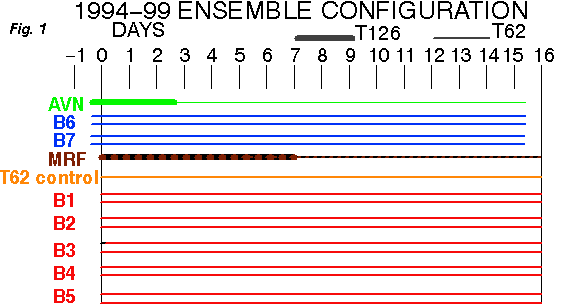
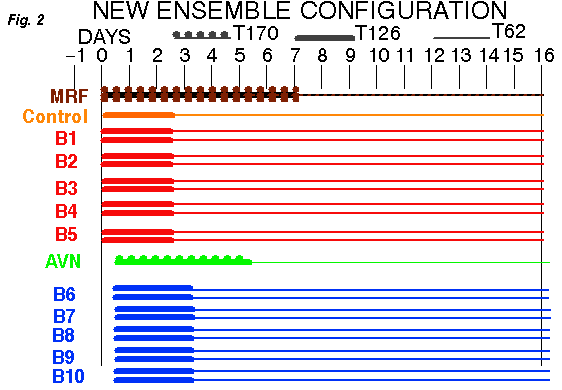 It
is expected that the resolution increase will be extended to 84 hrs lead
time in November 2000, and possibly out to 180 hrs in 2001. Below we compare
verification statistics for the period just before, and immediately after
the implementation. Because the results for the old vs. new configurations
are for different (yet adjacent) periods the results can be interpreted
as indicative (but not definitive) as for the impact of the implemented
changes. More definitive results are available for
It
is expected that the resolution increase will be extended to 84 hrs lead
time in November 2000, and possibly out to 180 hrs in 2001. Below we compare
verification statistics for the period just before, and immediately after
the implementation. Because the results for the old vs. new configurations
are for different (yet adjacent) periods the results can be interpreted
as indicative (but not definitive) as for the impact of the implemented
changes. More definitive results are available for
It was found, as expected, that the change in resolution had a
substantial impact on the quality of the ensemble forecasts. The rms error
of the ensemble control and mean forecasts is reduced (Figs.
3 and 4).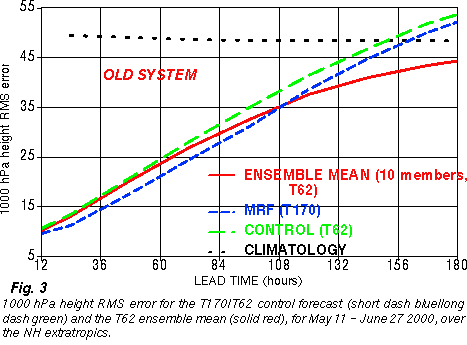
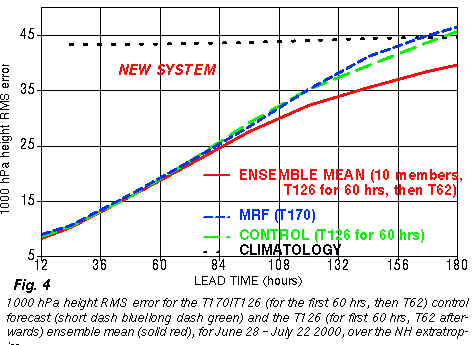 As
a result, the ensemble mean forecast now has scores that is equal to or
better than those for the T170 high resolution MRF control forecast at
all lead times. The gap between the ensemble mean error and ensemble spread,
which should ideally be equal, is also reduced (Fig.
5).
As
a result, the ensemble mean forecast now has scores that is equal to or
better than those for the T170 high resolution MRF control forecast at
all lead times. The gap between the ensemble mean error and ensemble spread,
which should ideally be equal, is also reduced (Fig.
5).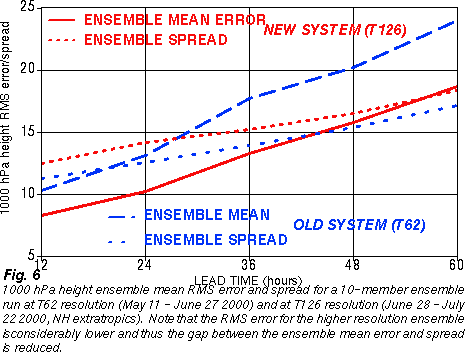 Moreover, the
cloud of ensemble forecasts misses the verification only 6% of the time,
compared to a 14% excessive missing rate (above that expected due to the
finite size of the ensemble) at 60 hrs lead time (Fig.
6).
Moreover, the
cloud of ensemble forecasts misses the verification only 6% of the time,
compared to a 14% excessive missing rate (above that expected due to the
finite size of the ensemble) at 60 hrs lead time (Fig.
6).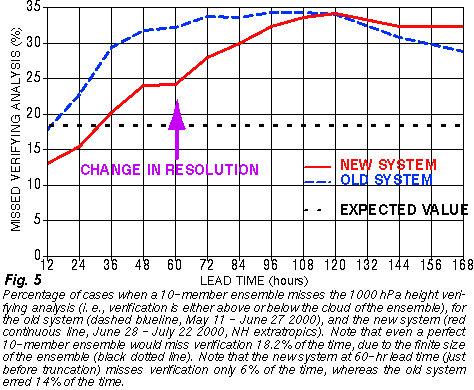 In addition, the
T170 high resolution control MRF forecast is the best member of the 23-member
ensemble only 5.1% of the time, only 19% more often than expected if all
members were equally likely (which correspondes to a 4.3% best verification
score, Fig. 7).
In addition, the
T170 high resolution control MRF forecast is the best member of the 23-member
ensemble only 5.1% of the time, only 19% more often than expected if all
members were equally likely (which correspondes to a 4.3% best verification
score, Fig. 7).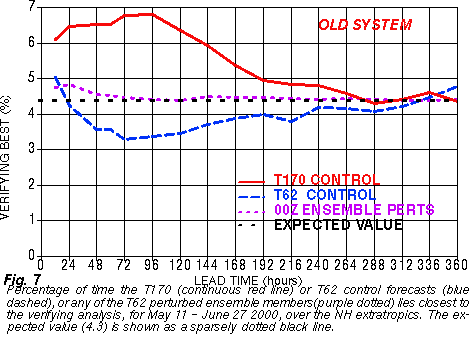 This is to be compared to 6.5% rate before the ensemble resolution increase,
which is 51% above the 4.3% expected best verification rate (Fig.
8).
This is to be compared to 6.5% rate before the ensemble resolution increase,
which is 51% above the 4.3% expected best verification rate (Fig.
8). 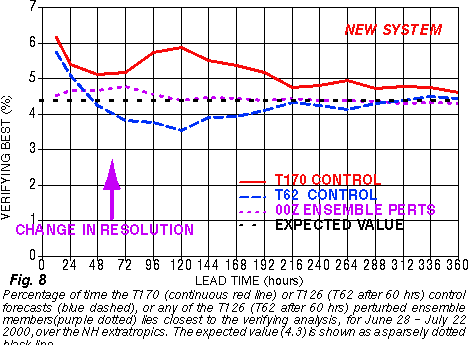
With the implemented changes the ensemble forecasts provide improved
forecast guidance twice a day. Regarding the possibility of the combined
use of the latest set of ensemble forecasts and the 12-hour older set of
ensemble, ensemble mean pattern anomaly correlation, rms (Fig.
9), 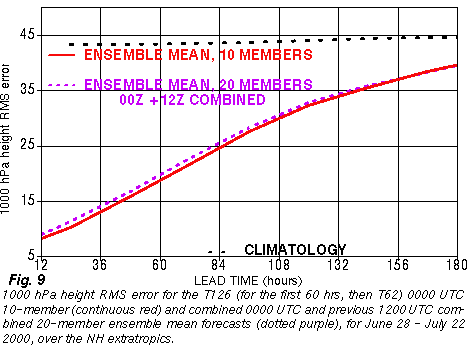 and probabilistic
verification scores (Fig. 10)
and probabilistic
verification scores (Fig. 10) 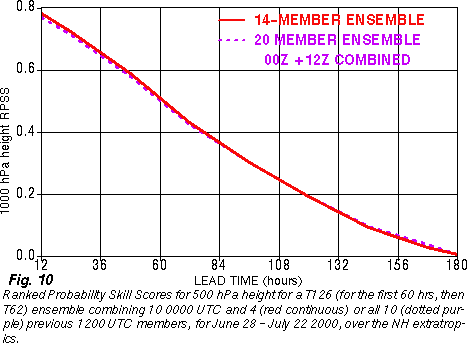 indicate
that the inclusion of the 12-hour older members degrades the quality of
the ensemble until 132-168 hours lead time is reached. Apparently the disadvantages
resulting from the inclusion of less skilful older members outweighs the
advantages of having more members until 6-7 days lead time or so. Therefore
it is recommended that for the first week only the latest set of ensemble
members are used in forecast applications.
indicate
that the inclusion of the 12-hour older members degrades the quality of
the ensemble until 132-168 hours lead time is reached. Apparently the disadvantages
resulting from the inclusion of less skilful older members outweighs the
advantages of having more members until 6-7 days lead time or so. Therefore
it is recommended that for the first week only the latest set of ensemble
members are used in forecast applications.

 As
a result, the ensemble mean forecast now has scores that is equal to or
better than those for the T170 high resolution MRF control forecast at
all lead times. The gap between the ensemble mean error and ensemble spread,
which should ideally be equal, is also reduced (Fig.
5).
As
a result, the ensemble mean forecast now has scores that is equal to or
better than those for the T170 high resolution MRF control forecast at
all lead times. The gap between the ensemble mean error and ensemble spread,
which should ideally be equal, is also reduced (Fig.
5). Moreover, the
cloud of ensemble forecasts misses the verification only 6% of the time,
compared to a 14% excessive missing rate (above that expected due to the
finite size of the ensemble) at 60 hrs lead time (Fig.
6).
Moreover, the
cloud of ensemble forecasts misses the verification only 6% of the time,
compared to a 14% excessive missing rate (above that expected due to the
finite size of the ensemble) at 60 hrs lead time (Fig.
6). In addition, the
T170 high resolution control MRF forecast is the best member of the 23-member
ensemble only 5.1% of the time, only 19% more often than expected if all
members were equally likely (which correspondes to a 4.3% best verification
score, Fig. 7).
In addition, the
T170 high resolution control MRF forecast is the best member of the 23-member
ensemble only 5.1% of the time, only 19% more often than expected if all
members were equally likely (which correspondes to a 4.3% best verification
score, Fig. 7). This is to be compared to 6.5% rate before the ensemble resolution increase,
which is 51% above the 4.3% expected best verification rate (Fig.
8).
This is to be compared to 6.5% rate before the ensemble resolution increase,
which is 51% above the 4.3% expected best verification rate (Fig.
8). 

 It
is expected that the resolution increase will be extended to 84 hrs lead
time in November 2000, and possibly out to 180 hrs in 2001. Below we compare
verification statistics for the period just before, and immediately after
the implementation. Because the results for the old vs. new configurations
are for different (yet adjacent) periods the results can be interpreted
as indicative (but not definitive) as for the impact of the implemented
changes. More definitive results are available for
It
is expected that the resolution increase will be extended to 84 hrs lead
time in November 2000, and possibly out to 180 hrs in 2001. Below we compare
verification statistics for the period just before, and immediately after
the implementation. Because the results for the old vs. new configurations
are for different (yet adjacent) periods the results can be interpreted
as indicative (but not definitive) as for the impact of the implemented
changes. More definitive results are available for
 and probabilistic
verification scores (
and probabilistic
verification scores ( indicate
that the inclusion of the 12-hour older members degrades the quality of
the ensemble until 132-168 hours lead time is reached. Apparently the disadvantages
resulting from the inclusion of less skilful older members outweighs the
advantages of having more members until 6-7 days lead time or so. Therefore
it is recommended that for the first week only the latest set of ensemble
members are used in forecast applications.
indicate
that the inclusion of the 12-hour older members degrades the quality of
the ensemble until 132-168 hours lead time is reached. Apparently the disadvantages
resulting from the inclusion of less skilful older members outweighs the
advantages of having more members until 6-7 days lead time or so. Therefore
it is recommended that for the first week only the latest set of ensemble
members are used in forecast applications.